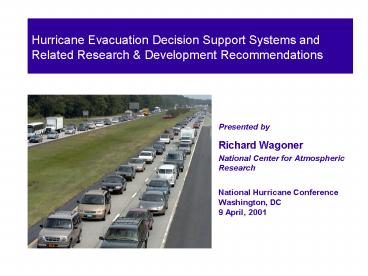Hurricane Evacuation Decision Support Systems and Related Research - PowerPoint PPT Presentation
Title:
Hurricane Evacuation Decision Support Systems and Related Research
Description:
Title: Integrating Weather Information Systems Across Air, Rail, Marine and Roadway Modes Author: Lara Ziady Last modified by: bhicks Created Date – PowerPoint PPT presentation
Number of Views:124
Avg rating:3.0/5.0
Title: Hurricane Evacuation Decision Support Systems and Related Research
1
Hurricane Evacuation Decision Support Systems and
Related Research Development Recommendations
Hurricane Evacuation Decision Support Systems and
Related Research Development Recommendations
- Presented by
- Richard Wagoner
- National Center for Atmospheric Research
- National Hurricane Conference
- Washington, DC
- 9 April, 2001
2
Winter Road Maintenance Decision Support System
(MDSS) Prototype Development
- Presented by
- Bill Mahoney
- National Center for Atmospheric Research
3
MDSS Objective
To utilize state-of-the-art atmospheric
science and engineering approaches to address
and improve the performance of the
road maintenance practitioner.
4
MDSS Goals
- Capitalize on existing road weather data
sources. - Augment data sources where they are weak.
- Fuse data to make an integrated and
- understandable presentation
- of road conditions.
- Provide diagnostic and prognostic information.
5
MDSS Goals (continued)
- Provide display capability for the condition
- of the roadway.
- Develop a decision support tool that provides
- recommendations on road maintenance
- courses of action together with anticipated
- consequences of action or inaction.
- Provide all the above on a single platform.
6
MDSS Prototype Components
Weather Data
Display
Advanced Weather Capabilities
DOT Operations Data
Decision Support Logic
Road Condition Module
External System Interface
7
MDSS Prototype Focus Areas
- Weather Component Focus
- Event start and stop times
- Surface temperature
- Precipitation type
- Precipitation rate
- Precipitation accumulation
- Conditional probabilities
- Surface wind speed
- Surface wind direction
- Surface visibility
8
MDSS Prototype Focus Areas
- Road Component Focus
- Pavement temperature and trends
- Pavement chemical concentration
- Pavement friction coefficient
- Pavement contamination
- (liquid, snow, ice, etc.)
- Snow drifting
9
MDSS Prototype Focus Areas
- Decision Support System Component Focus
- Monitor weather road conditions
- Monitor probability intensity of weather
threat - Crew scheduling
- Manage crew shifts
- Dispatch crews to treat roadway
- Coordinate emergency management
- Manage incidents
- Monitor crew working time
- Post event clean up
10
Proposed Engineering Approach for MDSS
Point Time Specific Output
NOAA Weather Data
Weather Parameter Output
DICAST
Forecast Module A
Forecast Integrator
Data Ingest
Forecast Module B
Forecast Module C
Post Processor
Forecast Module D
. . .
Forecast Product
DOT Wx Data
Forecast Module N
DOT Operations Data
Decision Support System Module
Road Condition Module
GIS Display
11
Conceptual System Diagram for MDSS
Point Time Specific Output
Weather Data
DICAST
Forecast Module A
Forecast Integrator
Data Ingest
Forecast Module B
Forecast Module C
Post Processor
Forecast Module D
. . .
Forecast Product
Forecast Module N
GIS Display
Chemical Concentration
12
Environmental Prediction Sites
Environmental prediction parameters will be
generated along the road. These data will be
used by the road condition algorithms.
13
Translation of Environmental Data to Road
Condition Information
14
Special Features of the MDSS
- Takes advantage of standard road weather
sensor data via intelligent data integration. - Utilizes an automated, high resolution forecast
system with advanced data fusion techniques. - Provides probability (confidence) information
for environmental parameters.
15
Special Features of the MDSS
- Has the capability of utilizing several road
condition algorithms to provide a best
solution. - Merges environmental operational data within
the DSS. - Provides decision guidance in decision space and
provides recommended courses of action and allows
users to evaluate other courses of action.
16
MDSS Technology Applications
Warning Preparation
Winter Maintenance
Paving Operations
Emergency Management
Pavement Marking
Traffic Management
Public Notification
Hurricane Evacuation
Sweeping Operations
Weed Spraying
Controlled Burns
17
Proposed Architecture of Hurricane Evacuation DSS
- Hurricane Evacuation Subsystem
- Focused on 24 48 hr period prior to gale force
winds on the coast - Updated every six hours in phase with NHC
advisories
- Uses weather, incident, maintenance and traffic
modeling data to show decision makers estimated
evacuation rates andproblem areas - Between update times, what if scenarios can be
run to estimate impact of track and intensity
changes
18
Proposed Architecture of Hurricane Evacuation DSS
Tactical Support for Emergency Response Subsystem
- Focused on weather and road conditions as gale
force winds, heavy rain, lightning and tornadoes
move inland - Continuous monitor mode with updates every 5 15
minutes - Maximum wind, accumulated rainfall, rainfall
rate, and lightning rate displayed for key
locations designated by emergency managers
19
Proposed Architecture of Hurricane Evacuation DSS
Tactical Support for Emergency Response Subsystem
- System will be used for timing post-storm
responses to ensure safety of crews - Storm location and past track displayed
- Future storm locations with estimatedwind and
rainfall forecasts displayed for every 3 hrs out
to 12 hours - Road condition information constantly updated
20
Recommended Research Development Areas
- Application of new data fusion techniques to TPC
operations to improve 1 5 day track and
intensity forecasts - Optimal methods for utilizing weather
informationin traffic models - Validation of DSSs in operational settings
21
The End wagoner_at_ucar.edu 303-497-8404

